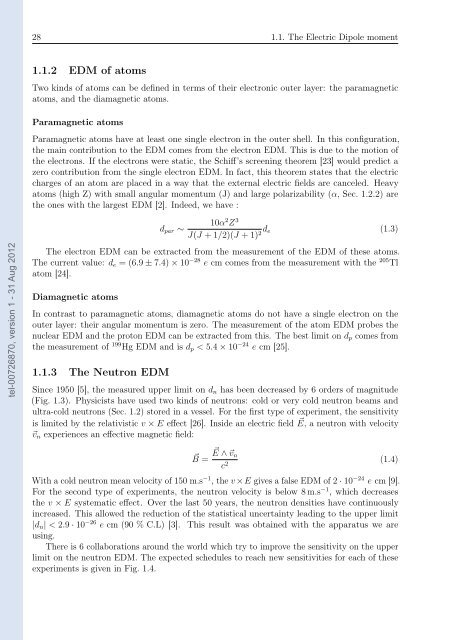Développement et optimisation d'un système de polarisation de ...
Développement et optimisation d'un système de polarisation de ...
Développement et optimisation d'un système de polarisation de ...
You also want an ePaper? Increase the reach of your titles
YUMPU automatically turns print PDFs into web optimized ePapers that Google loves.
tel-00726870, version 1 - 31 Aug 2012<br />
28 1.1. The Electric Dipole moment<br />
1.1.2 EDM of atoms<br />
Two kinds of atoms can be <strong>de</strong>fined in terms of their electronic outer layer: the paramagn<strong>et</strong>ic<br />
atoms, and the diamagn<strong>et</strong>ic atoms.<br />
Paramagn<strong>et</strong>ic atoms<br />
Paramagn<strong>et</strong>ic atoms have at least one single electron in the outer shell. In this configuration,<br />
the main contribution to the EDM comes from the electron EDM. This is due to the motion of<br />
the electrons. If the electrons were static, the Schiff’s screening theorem [23] would predict a<br />
zero contribution from the single electron EDM. In fact, this theorem states that the electric<br />
charges of an atom are placed in a way that the external electric fields are canceled. Heavy<br />
atoms (high Z) with small angular momentum (J) and large polarizability (α, Sec. 1.2.2) are<br />
the ones with the largest EDM [2]. In<strong>de</strong>ed, we have :<br />
dpar ∼<br />
10α2Z 3<br />
<strong>de</strong><br />
(1.3)<br />
J(J + 1/2)(J + 1) 2<br />
The electron EDM can be extracted from the measurement of the EDM of these atoms.<br />
The current value: <strong>de</strong> = (6.9 ± 7.4) × 10 −28 e cm comes from the measurement with the 205 Tl<br />
atom [24].<br />
Diamagn<strong>et</strong>ic atoms<br />
In contrast to paramagn<strong>et</strong>ic atoms, diamagn<strong>et</strong>ic atoms do not have a single electron on the<br />
outer layer: their angular momentum is zero. The measurement of the atom EDM probes the<br />
nuclear EDM and the proton EDM can be extracted from this. The best limit on dp comes from<br />
the measurement of 199 Hg EDM and is dp < 5.4 × 10 −24 e cm [25].<br />
1.1.3 The Neutron EDM<br />
Since 1950 [5], the measured upper limit on dn has been <strong>de</strong>creased by 6 or<strong>de</strong>rs of magnitu<strong>de</strong><br />
(Fig. 1.3). Physicists have used two kinds of neutrons: cold or very cold neutron beams and<br />
ultra-cold neutrons (Sec. 1.2) stored in a vessel. For the first type of experiment, the sensitivity<br />
is limited by the relativistic v × E effect [26]. Insi<strong>de</strong> an electric field E, a neutron with velocity<br />
vn experiences an effective magn<strong>et</strong>ic field:<br />
B = E ∧ vn<br />
c 2<br />
With a cold neutron mean velocity of 150 m.s −1 , the v ×E gives a false EDM of 2 · 10 −24 e cm [9].<br />
For the second type of experiments, the neutron velocity is below 8 m.s −1 , which <strong>de</strong>creases<br />
the v × E systematic effect. Over the last 50 years, the neutron <strong>de</strong>nsities have continuously<br />
increased. This allowed the reduction of the statistical uncertainty leading to the upper limit<br />
|dn| < 2.9 · 10 −26 e cm (90 % C.L) [3]. This result was obtained with the apparatus we are<br />
using.<br />
There is 6 collaborations around the world which try to improve the sensitivity on the upper<br />
limit on the neutron EDM. The expected schedules to reach new sensitivities for each of these<br />
experiments is given in Fig. 1.4.<br />
(1.4)

















